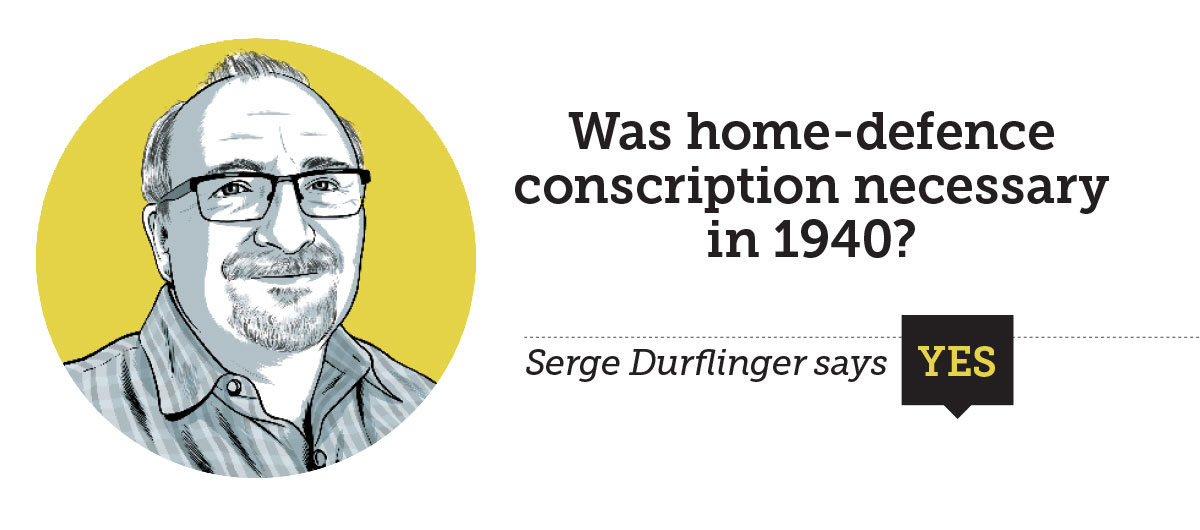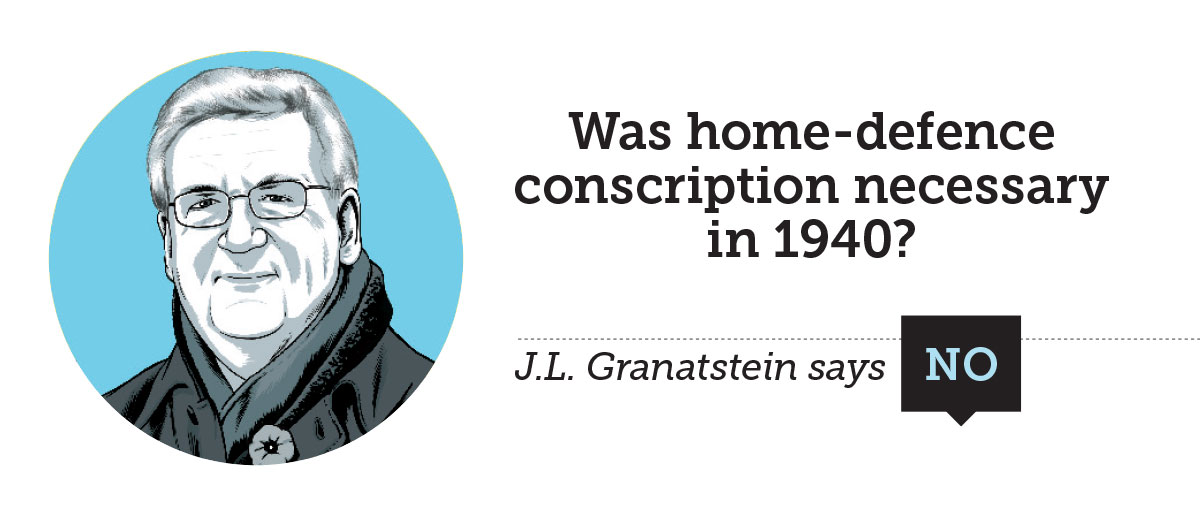
The government of William Lyon Mackenzie King was entirely justified in legislating the National Resources Mobilization Act (NRMA) on June 21, 1940, as a way to enhance Canada’s war readiness and assist Britain in its time of greatest peril.
Imposing limited conscription for the purpose of defending the nation was a sensible, measured reaction to the catastrophe unfolding in Europe, and the responsible thing to do.
Following Britain and France’s lead, Canada declared war on Germany in September 1939. As the period of the “Phoney War” ensued, there seemed no immediate crisis and recruiting remained voluntary given King’s promise not to enact conscription.
On May 10, the Germans invaded the Low Countries and France, quickly routing their armies as well as the British Expeditionary Force, the latter evacuating from the continent at Dunkirk (see page 44). The world was stunned, Canadians horrified. Italy entered the war at Germany’s side, and by the third week of June, the French had signed an armistice. Canada was shockingly thrust into the unanticipated role of the second-ranking ally.
A crisis mentality took hold. The British anticipated devastating bombing attacks and even an invasion. Ottawa, deeply worried over Britain’s and Canada’s own security, abandoned its policy of wartime “limited liability.”
The NRMA did not merely create an army of home-defence conscripts. It also served as an umbrella law under the authority of which were enacted a cavalcade of critical orders and regulations governing the mobilization of labour, industry, property and anything else that the country had to offer.
“A special emergency has arisen and the national safety of Canada has become endangered,” the act gravely announced.
Section 3 of the act makes clear that no Canadian called to the colours would be obliged to serve outside Canada or its territorial waters. Accordingly, Ottawa conscripted men aged 21 to 24 who would train for 30 days (increased to four months for subsequent drafts) and eventually serve for the duration of the war protecting our coasts, garrisoning defensive positions, and guarding vital installations.
Very few voices were raised in opposition to the measure, including in Quebec, although some among the Conservative Opposition and the press called on the government to impose full conscription for overseas service. But that would have precipitated a massive political crisis akin to that of 1917. The home-defence army was not a half measure; it was a first act on which further manpower policies might be, and were, based.
While it was improbable in 1940 that Canada would suffer any direct German attack—subsequent arrangements with the United States made this even less likely—Ottawa rightly felt that any policy that increased the number of men under arms, encouraged public war-mindedness and involvement in the war effort, and created a framework for enhanced national security, was the right one to adopt.
More than 150,000 Canadian men served as home-defence conscripts during the war. About 60,000 of these trained soldiers volunteered for general service overseas, one of the NRMA army’s greatest and often overlooked contributions.

Major-General Harry Crerar returned to Canada from Britain in July 1940 to become Chief of the General Staff, the head of the Canadian Army. Parliament had already passed the National Resources Mobilization Act (NRMA) the month before, very soon after the fall of France and the miracle of Dunkirk.
The NRMA provided for conscription for home defence, but Crerar was far from happy. The “pressure of public opinion” to “get on with the war” was so extreme, he said, that the Department of National Defence was going in all directions at the maximum possible speed. The NRMA, intended to call up 30,000 men a month for 30 days of training, was one sign of “a very superficial scheme” that, at best, might make men “military-minded,” wrote Crerar.
There was no shortage of volunteers—more than 150,000 officers and men had already enlisted for overseas service—but with a dearth of modern weapons and training staff, little could be done to turn conscripts into soldiers in a month.
The first class of home-defence conscripts reported on Oct. 9, 1940. Their “training” focused on sports, rifle marksmanship and the soldier’s life. In effect, the army was selling a lifestyle more than trying to turn civilians, shaped by “twenty years of pacifist debauchery,” one officer wrote, into soldiers. Crerar grumbled that this was all that could be accomplished “because all we could train with were U.S. rifles of last war vintage—and no ammunition!”
Still, it smacked of utter amateurishness when the military authorities in Toronto urged the third batch of draftees, due to report on Jan. 10, 1941, “to bring along any basketball or badminton equipment they have available.”
Not surprisingly, many draftees believed their “time had been well spent,” reported The Globe and Mail, “from the standpoint of health, education and downright fun.”
Even worse, no one in Ottawa had any idea what to do with the 30-day trainees. Incredibly, no one had thought to develop a way for men to volunteer for active service directly from NRMA training and, although the trainees were supposed to report to the nearest militia unit on completion of their 30 days, no one checked to see if they did. Many did not.
Was there even a credible threat to Canada in this period? There was no shortage of volunteers, the defence of Britain was the overriding priority, and Canada was stripping itself bare to this end. But the nation was still protected against possible threats, although not by the NRMA trainees. In August 1940, Prime Minister Mackenzie King met with President Franklin D. Roosevelt at Ogdensburg, N.Y., and the two leaders agreed to create the Permanent Joint Board on Defence. For the first time, Canada and the United States had a defence alliance, and the power of the United States, although not yet fully mobilized, guaranteed the security of the Dominion.
The NRMA conscripts eventually would play an important, if controversial, role. But in the summer of 1940, as Canada scrambled to create an army from almost nothing, the 30-day draftees were of no consequence. Indeed, they diverted scarce resources that might have been far better employed.
Advertisement





















